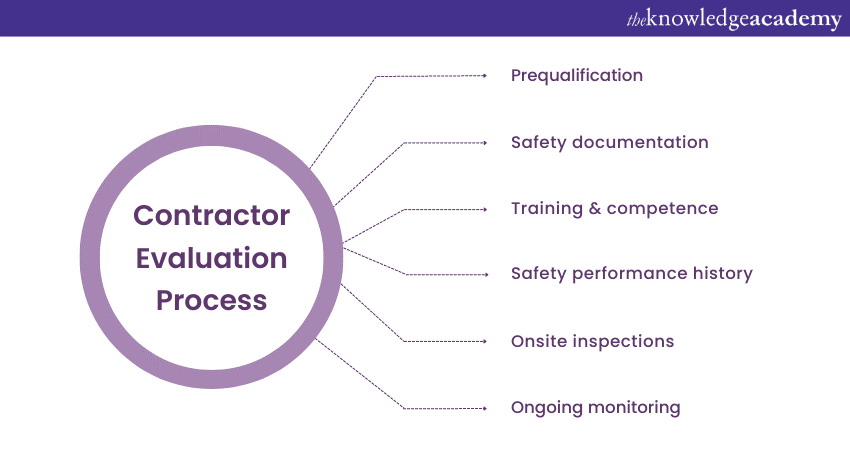We may not have the course you’re looking for. If you enquire or give us a call on +1 7204454674 and speak to our training experts, we may still be able to help with your training requirements.
Training Outcomes Within Your Budget!
We ensure quality, budget-alignment, and timely delivery by our expert instructors.

ISO 45001 Contractor Management ensures safe working environments by establishing guidelines for selecting, engaging, and monitoring Contractors. It emphasises collaboration, evaluation, and qualification of Contractors, promoting shared responsibility.
According to a study by ISO, ISO Contractor Management improves safety performance, reducing workplace accidents, injuries, and near misses. It creates a safer environment for employees and Contractors. Implementing this standard enhances an organisation's reputation and credibility and fosters a culture of safety. Read this blog to learn about ISO 45001 Contractor Management and how to ensure that Occupational Health and Safety Management System (OHSMS) has all the safeguards required.
Table of Contents
1) What is ISO 45001 Contractor Management?
2) Collaborative approach to Contractor Management
3) Contractor evaluation and qualification
4) Benefits of implementing Contractor Management
5) Conclusion
What is ISO 45001 Contractor Management?
ISO 45001 Contractor Management is a set of guidelines that help organisations ensure the safety of workers and Contractors. It focuses on effective Contractor Management to minimise risks and create a safe work environment. It promotes teamwork between organisations and Contractors, fostering a culture of safety.
A unique aspect is the evaluation and qualification of Contractors. Organisations assess Contractors' capabilities, track records, and commitment to safety before hiring them. ISO 45001 Contractor Management also highlights monitoring and control. Regular inspections and audits ensure Contractors follow safety protocols, allowing for timely corrective actions. Implementing ISO 45001, Contractor Management enhances an organisation's reputation and credibility.

Collaborative approach to Contractor Management
Establishing strong lines of communication with Contractors is important for fostering shared responsibility and promoting a culture of safety. Effective communication ensures that all parties involved have a clear understanding of safety expectations and goals. By maintaining open and transparent communication channels, organisations and Contractors can exchange vital information, identify potential hazards, and discuss safety procedures.

This enables Contractors to be well-informed and actively engage in mitigating risks associated with their tasks. Moreover, strong communication allows for the timely reporting of safety incidents, near misses, or concerns. This facilitates swift actions to rectify the situation, prevent accidents, and ensure a safer work environment.
When organisations and Contractors collaborate closely, they develop a sense of shared responsibility. Contractors can contribute their expertise, while organisations provide guidance and necessary resources. This collaboration fosters a proactive approach to safety, where everyone actively participates in Risk Management.
Gain a comprehensive understanding of ISO 45001 principles, purpose and policies with our ISO 45001 Training.
Contractor evaluation and qualification
The process of evaluating and qualifying Contractors according to ISO 45001 guidelines involves several key steps to ensure their capabilities and commitment to safety. The steps include:
a) Prequalification: Organisations assess potential Contractors before engaging them. This includes reviewing their qualifications, experience, and past performance to ensure they possess the necessary skills and expertise for the job.
b) Safety documentation: Contractors are required to provide documentation, such as safety policies, procedures, and records, demonstrating their compliance with safety regulations. This helps evaluate their commitment to maintaining a safe work environment.
c) Safety training and competence: Organisations verify that Contractors have provided adequate safety training to their employees. They assess the competence of Contractor personnel to make sure they possess the necessary knowledge and skills to perform tasks safely.
d) Safety performance history: Organisations review Contractors' safety performance records, including accident rates, near misses, and safety violations. This evaluation helps gauge their track record in managing safety and identifying any areas for improvement.
e) Onsite inspections: Physical inspections of Contractors' workplaces or ongoing projects may be conducted to assess their adherence to safety standards, the condition of equipment, and overall safety practices.
f) Ongoing monitoring: Once engaged, organisations continue to monitor Contractors' performance and adherence to safety protocols throughout the duration of the project. Regular audits, site visits, and communication ensure ongoing compliance.
Understand the principles and policies of ISO 45001 with our ISO 45001 Internal Auditor Course. Sign up now!
Benefits of implementing Contractor Management
Implementing Contractor Management brings a range of valuable benefits to organisations, some of them include:
a) By implementing Contractor Management, organisations prioritise safety and minimise workplace accidents, injuries, and near misses.
b) Contractor Management streamlines operations by establishing clear communication channels, efficient coordination, and proper allocation of resources.
c) Contractor Management ensures that organisations remain compliant with relevant regulations, reducing the risk of legal complications.
d) Contractor Management focuses on evaluating and selecting Contractors who meet defined quality standards. This ensures that the work performed by Contractors meets or exceeds expectations, leading to consistent quality output.
e)Contractor Management identifies potential risks and implements measures to mitigate them.
f) Implementing Contractor Management demonstrates a commitment to safety, efficiency, and responsible business practices.
g) Contractor Management encourages collaboration and shared responsibility between organisations and Contractors.
Conclusion
We hope this blog gave you enough insights into ISO 45001 Contractor Management. It ensures safety, efficiency, and collaboration leading to a secure work environment. By evaluating Contractors, monitoring progress, and fostering open communication, ISO 45001 promotes a safety culture and builds stakeholder confidence. Therefore, implementing ISO 45001 is a must for a safer, more productive workplace.
Excel in the field of occupational health and safety Management systems with our ISO 45001 Lead Implementer Course. Sign up today!
Frequently Asked Questions
Upcoming Health & Safety Resources Batches & Dates
Date
 ISO 45001 Foundation
ISO 45001 Foundation
Mon 10th Feb 2025
Mon 14th Apr 2025
Mon 16th Jun 2025
Mon 11th Aug 2025
Mon 13th Oct 2025
Mon 8th Dec 2025







 Top Rated Course
Top Rated Course


 If you wish to make any changes to your course, please
If you wish to make any changes to your course, please


